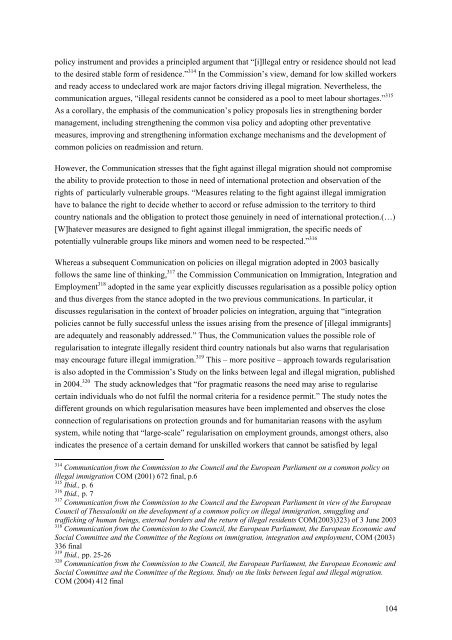REGINE Regularisations in Europe Final Report - European ...
REGINE Regularisations in Europe Final Report - European ...
REGINE Regularisations in Europe Final Report - European ...
Create successful ePaper yourself
Turn your PDF publications into a flip-book with our unique Google optimized e-Paper software.
policy <strong>in</strong>strument and provides a pr<strong>in</strong>cipled argument that “[i]llegal entry or residence should not lead<br />
to the desired stable form of residence.” 314 In the Commission’s view, demand for low skilled workers<br />
and ready access to undeclared work are major factors driv<strong>in</strong>g illegal migration. Nevertheless, the<br />
communication argues, “illegal residents cannot be considered as a pool to meet labour shortages.” 315<br />
As a corollary, the emphasis of the communication’s policy proposals lies <strong>in</strong> strengthen<strong>in</strong>g border<br />
management, <strong>in</strong>clud<strong>in</strong>g strengthen<strong>in</strong>g the common visa policy and adopt<strong>in</strong>g other preventative<br />
measures, improv<strong>in</strong>g and strengthen<strong>in</strong>g <strong>in</strong>formation exchange mechanisms and the development of<br />
common policies on readmission and return.<br />
However, the Communication stresses that the fight aga<strong>in</strong>st illegal migration should not compromise<br />
the ability to provide protection to those <strong>in</strong> need of <strong>in</strong>ternational protection and observation of the<br />
rights of particularly vulnerable groups. “Measures relat<strong>in</strong>g to the fight aga<strong>in</strong>st illegal immigration<br />
have to balance the right to decide whether to accord or refuse admission to the territory to third<br />
country nationals and the obligation to protect those genu<strong>in</strong>ely <strong>in</strong> need of <strong>in</strong>ternational protection.(…)<br />
[W]hatever measures are designed to fight aga<strong>in</strong>st illegal immigration, the specific needs of<br />
potentially vulnerable groups like m<strong>in</strong>ors and women need to be respected.” 316<br />
Whereas a subsequent Communication on policies on illegal migration adopted <strong>in</strong> 2003 basically<br />
follows the same l<strong>in</strong>e of th<strong>in</strong>k<strong>in</strong>g, 317 the Commission Communication on Immigration, Integration and<br />
Employment 318 adopted <strong>in</strong> the same year explicitly discusses regularisation as a possible policy option<br />
and thus diverges from the stance adopted <strong>in</strong> the two previous communications. In particular, it<br />
discusses regularisation <strong>in</strong> the context of broader policies on <strong>in</strong>tegration, argu<strong>in</strong>g that “<strong>in</strong>tegration<br />
policies cannot be fully successful unless the issues aris<strong>in</strong>g from the presence of [illegal immigrants]<br />
are adequately and reasonably addressed.” Thus, the Communication values the possible role of<br />
regularisation to <strong>in</strong>tegrate illegally resident third country nationals but also warns that regularisation<br />
may encourage future illegal immigration. 319 This – more positive – approach towards regularisation<br />
is also adopted <strong>in</strong> the Commission’s Study on the l<strong>in</strong>ks between legal and illegal migration, published<br />
<strong>in</strong> 2004. 320 The study acknowledges that “for pragmatic reasons the need may arise to regularise<br />
certa<strong>in</strong> <strong>in</strong>dividuals who do not fulfil the normal criteria for a residence permit.” The study notes the<br />
different grounds on which regularisation measures have been implemented and observes the close<br />
connection of regularisations on protection grounds and for humanitarian reasons with the asylum<br />
system, while not<strong>in</strong>g that “large-scale” regularisation on employment grounds, amongst others, also<br />
<strong>in</strong>dicates the presence of a certa<strong>in</strong> demand for unskilled workers that cannot be satisfied by legal<br />
314 Communication from the Commission to the Council and the <strong>Europe</strong>an Parliament on a common policy on<br />
illegal immigration COM (2001) 672 f<strong>in</strong>al, p.6<br />
315 Ibid., p. 6<br />
316 Ibid., p. 7<br />
317 Communication from the Commission to the Council and the <strong>Europe</strong>an Parliament <strong>in</strong> view of the <strong>Europe</strong>an<br />
Council of Thessaloniki on the development of a common policy on illegal immigration, smuggl<strong>in</strong>g and<br />
traffick<strong>in</strong>g of human be<strong>in</strong>gs, external borders and the return of illegal residents COM(2003)323) of 3 June 2003<br />
318 Communication from the Commission to the Council, the <strong>Europe</strong>an Parliament, the <strong>Europe</strong>an Economic and<br />
Social Committee and the Committee of the Regions on immigration, <strong>in</strong>tegration and employment, COM (2003)<br />
336 f<strong>in</strong>al<br />
319 Ibid., pp. 25-26<br />
320 Communication from the Commission to the Council, the <strong>Europe</strong>an Parliament, the <strong>Europe</strong>an Economic and<br />
Social Committee and the Committee of the Regions. Study on the l<strong>in</strong>ks between legal and illegal migration.<br />
COM (2004) 412 f<strong>in</strong>al<br />
104
















